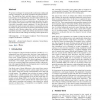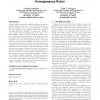9 search results - page 1 / 2 » Optimizing locomotion controllers using biologically-based a... |
TOG
2012
11 years 7 months ago
2012
We present a technique for automatically synthesizing walking and running controllers for physically-simulated 3D humanoid characters. The sagittal hip, knee, and ankle degrees-of...
SIGGRAPH
2010
ACM
13 years 9 months ago
2010
ACM
This paper introduces an approach to control of physics-based characters based on high-level features of movement, such as centerof-mass, angular momentum, and end-effectors. Obje...
TOG
2012
11 years 7 months ago
2012
We present a physically-based system to simulate and control the locomotion of soft body characters without skeletons. We use the finite element method to simulate the deformatio...
CDC
2009
IEEE
13 years 9 months ago
2009
IEEE
— The task in control allocation is to determine how to generate a specified generalized force from a redundant set of control effectors where the associated actuator control in...
GECCO
2009
Springer
13 years 11 months ago
2009
Springer
A central tenet of embodied artificial intelligence is that intelligent behavior arises out of the coupled dynamics between an agent’s body, brain and environment. It follows t...


